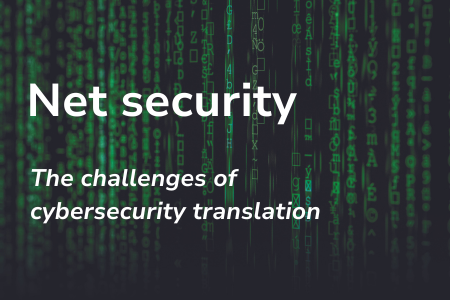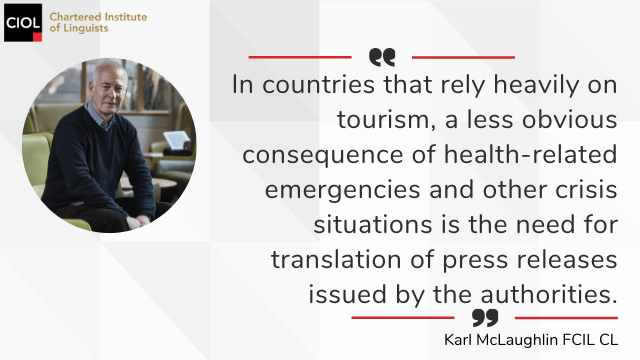-
QUALIFICATIONS
- For Linguists Worldwide
- For UK Public Services
- Preparation
- Policies & Regulation
-
MEMBERSHIP
- Join CIOL
- Membership grades
- NEW for Language Lovers
- Chartered Linguist
- Already a member?
- Professional conduct
- Business & Corporate Partners
-
ASSESSMENTS
- For Second Language Speakers
- English as a Second Language
-
TRAINING & EVENTS
- CIOL Conference Season 2025
- CPD, Webinars & Training
-
NEWS & VOICES
- News & Voices
- CIOL eNews
- CIOL Awards
- The Linguist
- Jobs & Ads
-
RESOURCES
- For Translators & Interpreters
- For Universities & Students
- Standards & Norms
- CIOL & AI
- All Party Parliamentary Group
- In the UK
- UK Public Services
- Find-a-Linguist
Net security
By Nataliya Yachmeneva

Nataliya Yachmeneva outlines the challenges of cybersecurity translation and understanding the concepts behind the terminology
We all bear witness to the breakneck speed at which the concepts of IT and cybersecurity have been evolving, together with software and hardware designed to counteract growing cybercrime. No dictionaries can keep up with the related terminology, while tech talk is often so informal and full of implication that you wonder if industry insiders can read each other’s minds. For a translator, this means intense research every time you translate and constant self-education. Having friends who work in the field also helps.
Cybersecurity is an important segment of the Russian IT market, with such players as Kaspersky, Dr.WEB and AVZ. I first got into this area when a major translation agency in Russia specialising in software translation offered training for prospective providers. I worked mainly with the marketing side of cybersecurity; that meant a nice cross between creative style and technical knowledge.
Translation in IT and cybersecurity throws up such issues as acronyms and abbreviations (‘RAM’, ОЗУ; ‘GHz’, ГГц; ‘QoS’, качество обслуживания), neologisms (‘Trojan’, троянская программа; ‘phishing’, фишинг; ‘sneaker-network’, флоппинет) and Americanisms (from spellings like ‘center’ and ‘analyze’ to expressions related to baseball). Challenges also come from product, company and department names (‘Global Research and Analysis Team’/‘GReAT’, глобальный центр исследования и анализа угроз) and job titles (‘chief information security officer’/ ‘CISO’, руководитель/директор по информационной безопасности).
To translate successfully in cybersecurity, you must be aware of both general IT terminology and the jargon typical of this area. General terminology includes everything from the fundamental concepts of computer science and the principles behind networks, to computational processes, operating systems, user interface elements and physical devices.
An example is the basic term ‘application’, which can be translated as программа (‘program’). To a layperson this is an old-fashioned name for an app; to a developer it means the code behind it. A better term in most cases will be приложение, which is the result of this code that we can see on the screen and use for everyday purposes.
‘Latency’ can be translated as латентность (the benefit here being brevity and close resemblance to the English term) but also as задержка (lit. ‘delay’) or время ожидания (‘waiting time’), both of which better convey the meaning of this concept. Similarly, ‘provisioning’ (the name of a process) does not tell us much, so the translator needs to understand what it means (preparing a system for work or use1) and employ a description (подготовка к работе/эксплуатации).
Cyber-specific terms
Specialised terminology for cybersecurity describes possible vulnerabilities, detection and protection techniques, types of malicious actions and malware. Some terms (e.g. ‘exploit’, ‘rootkit’) use established loan words in the target language (эксплойт, руткит). As translators, we need to familiarise ourselves with such conventions. You will also come across such terms as ‘health’, which refers to the condition of a system and whether it is running properly. It can be translated as состояние (‘state, condition’) or здоровье (lit. ‘health’); the choice will often depend on the register, the latter being more informal.
In English, phrases can often be shortened while remaining intelligible to the reader, but in Russian more detail may be required. ‘Real-time antivirus’ is a condensed construction, typical of the English language, that requires a more detailed description in Russian: антивирусная защита в режиме реального времени (lit. ‘antiviral protection in the real-time mode’). I would translate ‘web-cam protection’ as защита от взлома веб-камеры, specifying ‘protection from web-cam hacking’.
Sometimes, as in all specialised fields, there are sloppy or implicit expressions. One of my assignments contained the term ‘fraudulent database’ but it was not clear what this meant. Fortunately, a description in the source text indicated that it referred to a database of fraudulent URLs, so the translation was база адресов мошеннических веб-сайтов.
In order to feel and sound confident about the subject matter, the translator needs to understand what a term means – for example that a ‘0-day threat’ (угроза нулевого дня) is a type of threat that uses a yet unknown vulnerability in the system to worm its way inside.2 Sometimes the required information may be contained in the source text, but when the reference is a cutting-edge piece of technology the translator will have to explore the landscape and create a new word.
In many cases the translator can do initial research by using the search tool (e.g. Ctrl+F) across the whole source batch. I found this the easiest starting point to fetch full spellings for abbreviations, as well as definitions of some terminology (unless you can find them in the Translation Memory).
For abbreviations, Acronym Finder online is my second option. Another good strategy is to google ‘abbreviation+company name’ and similar combinations. Wikipedia, with its switchable languages, can be a good initial source too, especially as it offers references to source information at the bottom of the page. Official standards (GOSTs) can be used for all kinds of technical terminology in Russian.
When it comes to product names, they often stand on their own in English, while in Russian they usually require a general term such as ‘solution’ or ‘product line’. To add the right term, the translator needs to understand what they are dealing with. Kaspersky Anti-Virus (KAS) and Kaspersky Internet Security (KIS) are product lines, so the category name will be added in Russian (линейка продуктов KAV/KIS), while iChecker and iSwift are technology (технология iChecker).
This also takes us to the official product names. For instance, Kaspersky Total Security for Business will become Kaspersky Total Security для бизнеса, but Kaspersky Security for xSP will be partially translated as Kaspersky Security для xSP. You need to consult the client’s guidelines and do your own research to decide when to translate, when to keep the item in English and when to use a description. The company’s website is another good source of information.
Grammatical differences
Similar issues arise with components, interface elements and commands. Thus, it is hard to translate ‘System Watcher’ directly, so it becomes Мониторинг активности (lit. ‘Monitoring of activity’; a nomination of an active doer in English turns into a gerund in Russian). The command ‘Run in protected browser’ (an imperative) becomes Открыть в защищенном браузере (an infinitive). This is due to the tradition established in Russian scientific and technical writing, which is often more austere than the style used in English.
There is also a requirement in Russian to highlight user interface elements (such as the command mentioned above) with quotation marks, bold text or something else. To decide which ‘highlighter’ to use, the translator should consult the client’s guidelines or check what is used across the already translated interface.
Although flowing and effortless Russian is expected most of the time, in some cases the client’s guidelines require digression from the rules: for instance Анти-Спам for ‘Anti-Spam’ even though Russian grammar rules dictate that we use lower case and probably write it as one word. Checking the company’s website can be helpful in such cases, especially if it offers an option to switch languages. At times I have resorted to looking for snapshots of user interfaces online for hours, or even installing software, subscribing to demo versions and registering on specialist forums.
Knowing the field
In the beginning, I took (and loved) a free course in computer networks on Coursera, which was challenging and informative, and taught me all about the infamous Trudy (IT slang for a malicious intruder). For the Russian language, a few translation agencies provide rich resources, including vocabularies, webinars and blogs. For example, Evgeniy Bartov with Alliance PRO3 runs a school for specialist translators, including those working in IT. He regularly publishes useful posts, glossaries and analysis of errors in translation. Some market players publish glossaries, such as Kaspersky’s extensive bilingual glossary for English and Russian.4
Translating in IT and cybersecurity takes a lot of effort but helps you keep up to date with technology and can make you feel elated when you finally crack a particularly hard problem. It is rewarding to be knowledgeable about the ways to protect yourself and how such systems work.
Notes
1 cutt.ly/provisioning
2 cutt.ly/0day
3 tran.su
4 encyclopedia.kaspersky.ru/glossary
Nataliya Yachmeneva MCIL is a professional linguist with experience in different areas of marketing translation (including IT and automotive), as well as translation for corporate purposes and international events. She now works as a public service interpreter.
This article is reproduced from the Winter 2023/2024 issue of The Linguist. Download the full edition here.
More
The Chartered Institute of Linguists (CIOL), Incorporated by Royal Charter, Registered in England and Wales Number RC 000808 and the IoL Educational Trust (IoLET), trading as CIOL Qualifications, Company limited by Guarantee, Registered in England and Wales Number 04297497 and Registered Charity Number 1090263.








